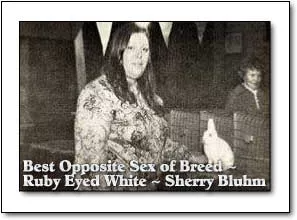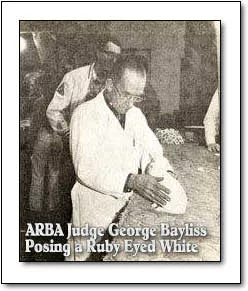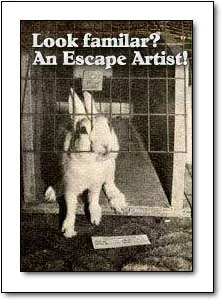History of the Britannia Petite
- abprs77
- Nov 7, 2021
- 4 min read
Updated: Oct 20
The American Britannia Petite originated in England and is known there as the Polish. When they were brought to the United States and accepted by the American Rabbit Breeders Association they were given the name Britannia Petites as there was already a recognized breed known by the name Polish. In England colored Petites have been shown with the Ruby Eyed Whites for many years. Originally, the American Rabbit Breeders Association only recognized the Ruby Eyed White, but since that time has accepted the Black Otter, Chestnut Agouti, Black, Sable Marten, Broken and Blue Eyed White.
Warren & Wendy Pocha got the (REW) Britannia Petite accepted by ARBA in 1977.
Rene Goedderz got the following Varieties approved: Black Otters in 1992, Black & Chestnut Agouti in 1995, Sable Marten in 1997, Broken in 2012 and Blue Eyed White in 2014.
Debbie Hilton and Tara Wolf got the following varieties approved: Siamese Sable 2018, Debbie Hilton got the following varieties approved: The Himalayan and Tort groups 2022.
Many dedicated breeders are working hard to insure that the Britannia Petites become a strong influence in the rabbit world. The Britannia Petite is a very old breed, and at one time they were near the point of extinction, but a few dedicated breeders were able to save these sprightly little rabbits. The Britannia Petites were once a much larger animal than they are now. The ideal weight of the Britannia Petite is 2 1/4 pounds, fully grown. They are one of the smallest breeds of domestic rabbits.
The Britannia Petites are sprightly upright little show offs. With patience and proper handling, a judge experienced in handling Britannia Petites should be able to get the animal to pose naturally. However, after working with them and giving them the opportunity to show themselves in an upright pose, they should only be mildly faulted if they fail to do so. Because they are an active rabbit by nature, they do not require much prodding to show off. They require a lot of handling and table training to ready them for show presentation. A commitment of time and patience is required to guide one of these lovely animals to show themselves off to their best advantage. One of the first things you hear about the Britannia Petites is, “how pretty but aren't they mean little rabbits?” They have earned somewhat of an unjust reputation from a few of the wild and seldom handled specimens being shown. The Britannia Petite is a naturally high strung animal that is very lively and very intelligent. Consequently, they require a patient attitude on your part to successfully work with them. A responsive and interacting relationship is a must if you want to enjoy this active little rabbit.
When the does are in heat and ready to breed, they can become very aggressive as can bucks intent on breeding.. Most new mothers are very protective of their young and resent intrusions, especially from a stranger. This is a common practice for most breeds of domestic rabbit, but the high strung nature of the Britannia Petites with their quickness and agility can sometimes require special attention in order to perform your usual cage duties. A small treat sometimes will distract the doe temporarily, allowing you to check the nest quietly and easily. Young Britannia Petites, with careful handling and a reassuring tone of voice soon become very responsive to your wishes. They have an abundance of energy, which when redirected properly should allow you to be able to handle them without fear for your fingers. In short treat them right and you'll reap the reward of having a unique little rabbit that is awed by most who see them. Once they have become used to your handling, they may be trained to assume the show pose. This requires patience and repetitive placement for short periods every day. Praise them when they do well and soon they will eagerly perform for you.
Housing for the Britannia Petite, doesn't need to be overly large or extravagant. If kept in a cage too large, they can easily be startled, sometimes even resulting in injury. I have found the ideal size cage for Does to be 18" W X 24" D X 14" H . I keep my Bucks in cages 18" D X 18" W X 14" H...they seem to feel more secure in a smaller cage. I have found that if you can get floor wire that is 1/2" X 1/2" instead of the standard 1/2" X 1" , the baby Britannia Petites have less trouble moving around in the cage, and being so tiny I have seen them break a leg if they get startled. Some breeders use solid bottom cages, constructed of wood, but you should consider one very important factor...cage cleaning... if you use wooden bottoms you will have a lot more cleaning to do.
Feed Requirements are the same as most other domestic rabbits as quality of feed is very important. I have found they do well on rabbit pellets, oats and hay. Using 1/3 to 1/2 measuring cup of pellets a day should be adequate, and adjust it accordingly to each individual rabbit, more if it's a doe with a litter. Of course they do a little better with a variety of treats such as alfalfa cubes, shredded wheat biscuits, cheerios breakfast cereal, dry toast, carrots, green leafy vegetables. Be very careful when giving them treats as changes in their diet can cause digestive upsets. Plenty of fresh water is a mandatory requirement with any breed of rabbit.
The Britannia Petites are a fascinating little rabbit which provide an interesting challenge. Sleek and stylish, independent and alert, they are truly a "fancier's fancy", deserving the title the "Elite of the Fancy". Britannia Petites are not for everyone, but with perseverance and patience, they will reward your time and effort, providing you with an eye catching show animal. Watching this little rabbit respond to your training and handling is well worth it. It is truly a sight to see when you have a Britannia Petite hold the show pose as if it were a statue.








